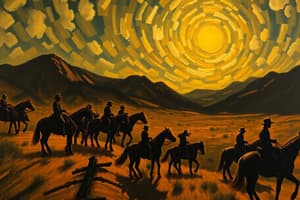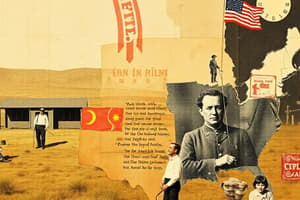Podcast
Questions and Answers
¿Cuál fue el efecto más significativo de la Ley de Homestead de 1862 en la expansión hacia el oeste de Estados Unidos?
¿Cuál fue el efecto más significativo de la Ley de Homestead de 1862 en la expansión hacia el oeste de Estados Unidos?
- Limitó la inmigración de europeos buscando mejores tierras.
- Proporcionó tierras a quienes permanecieran en ellas durante cinco años. (correct)
- Facilitó la construcción de ferrocarriles transcontinentales.
- Estableció rutas de migración para esclavos fugitivos.
¿Qué concepto se relaciona más estrechamente con la idea de que Estados Unidos tenía la responsabilidad de expandir sus ideales hacia el oeste?
¿Qué concepto se relaciona más estrechamente con la idea de que Estados Unidos tenía la responsabilidad de expandir sus ideales hacia el oeste?
- Destino manifiesto. (correct)
- Separación de poderes.
- Sufragio universal.
- Gobierno limitado.
¿Cuál fue una similitud entre Frederick Douglass y William Lloyd Garrison?
¿Cuál fue una similitud entre Frederick Douglass y William Lloyd Garrison?
- Ambos promovieron el movimiento abolicionista. (correct)
- Ambos eran críticos del movimiento de sufragio.
- Ambos apoyaron la Revolución Industrial.
- Ambos defendieron la expansión de la esclavitud en el sur.
¿Cuál fue el propósito principal de los Compromisos de Missouri de 1820 y el de 1850?
¿Cuál fue el propósito principal de los Compromisos de Missouri de 1820 y el de 1850?
¿Qué decisión importante se tomó en el caso de Dred Scott en 1857?
¿Qué decisión importante se tomó en el caso de Dred Scott en 1857?
Flashcards
¿Qué llevó a la expansión de la esclavitud en el sur?
¿Qué llevó a la expansión de la esclavitud en el sur?
La expansión de la esclavitud en el sur de Estados Unidos a mediados del siglo XIX se debió a la creciente producción de algodón gracias a nuevas innovaciones en la agricultura.
Ley de Tierras de 1862 (Homestead Act)
Ley de Tierras de 1862 (Homestead Act)
Ley que incentivó la colonización del oeste de Estados Unidos al proporcionar tierras a los colonos que vivieran en ellas durante al menos cinco años.
Compromisos de 1820 y 1850 (Missouri Compromise y Compromise of 1850)
Compromisos de 1820 y 1850 (Missouri Compromise y Compromise of 1850)
Intentos del gobierno federal de reducir los conflictos sobre la esclavitud a través de acuerdos y medidas políticas.
Movimiento abolicionista
Movimiento abolicionista
Signup and view all the flashcards
Destino Manifiesto
Destino Manifiesto
Signup and view all the flashcards
Study Notes
Westward Expansion
- Gold rush (1849) spurred westward migration, increasing populations in California and western territories.
- Homestead Act (1862) offered free land to settlers, focusing primarily on the Great Plains; demonstrating a commitment to westward settlement by the federal government.
- Pacific/Transcontinental Railroad Act (1862) facilitated the construction of the transcontinental railroads by granting land to railroad companies in the second half of the 1800s.
- Manifest Destiny: The idea that the US was destined to expand across the entire continent. Advocates used this to justify westward expansion and annexation of lands from other nations (e.g., Texas, Mexican War). This was opposed by abolitionists who feared the admission of new slave states.
- Abolitionist Movement: Prominent figures like William Lloyd Garrison, Harriet Tubman, and Harriet Beecher Stowe fought against slavery and the expansion of it into new western territories.
- Territorial Expansion and Slavery Conflicts: The westward expansion exacerbated tensions over slavery; new territories led to questions about whether they should be free or slave states. This led to compromises.
- Missouri Compromise (1820), Compromise of 1850, Kansas-Nebraska Act (1854): Efforts to address the spread of slavery in new territories. The goal was to maintain a balance between free and slave states in Congress. The Missouri Compromise, for example, admitted Missouri as a slave state and Maine as a free state.
- Missouri Compromise: Admitted Missouri as a slave state and Maine as a free state to balance power in Congress between free and slave states.
- Compromise of 1850: A series of five laws meant to mediate slavery's expansion after the Mexican-American War.
- Kansas-Nebraska Act(1854): Created Kansas and Nebraska territories, allowing residents to decide whether to permit slavery through popular sovereignty.
Dred Scott v. Sandford (1857)
- Supreme Court decision ruling that Congress could not prohibit slavery in the territories.
Plantations
- Large Southern farms using enslaved labor, with a geographic advantage contributing to the growth of the plantation system and increase in cotton production throughout the first half of the 1800s.
Bleeding Kansas
- Term describing the violent clashes between proslavery and anti-slavery groups in Kansas.
Uncle Tom's Cabin
- Novel by Harriet Beecher Stowe that depicted slavery and contributed to the build-up to the Civil War by intensifying Northern opposition to slavery.
Underground Railroad
- Secret network assisting enslaved people to escape to free states in the North, often led by Harriet Tubman.
Homestead Act (1862)
- Provided land for settlement in the West.
Manifest Destiny
- Belief that the US was destined to expand across the North American continent.
Popular Sovereignty
- The concept that settlers in new territories had the right to decide whether slavery would be permitted there. (Emphasized in the Kansas-Nebraska Act)
Summary of Conflicts
- The expansionism of the US led to inevitable clashes over the issue of slavery.
- The disagreements and debates over slavery in territories acquired through westward expansion directly contributed to the eventual outbreak of the Civil War.
Studying That Suits You
Use AI to generate personalized quizzes and flashcards to suit your learning preferences.




